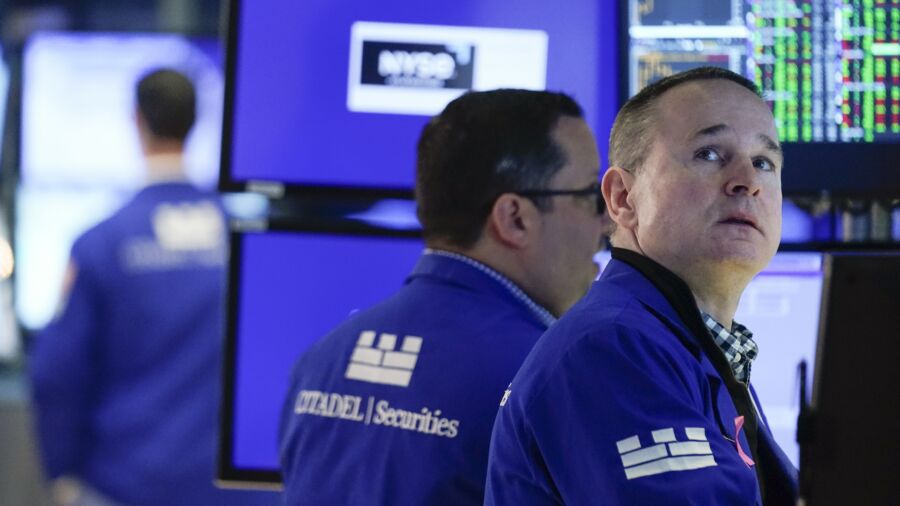The benchmark 10-year U.S. Treasury yield surged to its highest level in 16 years after the Federal Reserve suggested more rate hikes might be needed to fight “significant upside risks to inflation” in the latest policy minutes.
The 10-year yield picked up 3 basis points to finish the Aug. 16 trading session at 4.29 percent—the highest close since October 2007. The real yield (inflation-adjusted) is 1.9 percent, the highest since July 2009.
The overall Treasury market was up across the board. The 2-year yield added 1.1 basis points to 4.991 percent, while the 30-year yield jumped 2.1 basis points to 4.381 percent.
The Federal Reserve published the July Federal Open Market Committee (FOMC) policy meeting minutes. Rate-setting Committee members refrained from declaring victory in their inflation fight, warning of “significant upside risks to inflation” that might require additional monetary tightening to achieve the central bank’s 2 percent objective.
But meeting participants were also cautious about the risks of going too far since monetary policy is already in restrictive territory.
“A number of participants judged that, with the stance of monetary policy in restrictive territory, risks to the achievement of the Committee’s goals had become more two sided, and it was important that the Committee’s decisions balance the risk of an inadvertent overtightening of policy against the cost of an insufficient tightening,” the meeting summary stated.
Since March 2022, the Fed has raised interest rates 11 times for a total of about 500 basis points to a target range of 5 percent and 5.25 percent. The institution held the benchmark fed funds rate steady in June to assess the overall economy and determine if the tightening cycle has cooled economic conditions, tackled inflation, and doused the red-hot labor market.
Heading into the September FOMC meeting, there will be another jobs report and more inflation figures.
Meanwhile, investors will have an eye on the Kansas City Fed Bank’s annual symposium in Jackson Hole, Wyoming, between Aug. 24 and Aug. 26.
Treasury Yields and Interest Rates
Is elevated Treasury yields the new normal? As the bond market continues to touch fresh highs, this is the newest debate in the financial markets.
Former Treasury Secretary Larry Summers believes higher long-term rates “are with us to stay,” and could trend even higher. The 10-year yield could average 4.75 percent in the coming decade after averaging about 2.9 percent over the last two decades.

“I don’t particularly see the current level of longer-term rates as any kind of peak,” Mr. Summers told Bloomberg TV on Aug. 16, adding that the U.S. economy is in a different era, alluding to changes in the labor market and international trade.
If Mr. Summers’ projections are accurate, it would have a spillover effect on the real economy, especially in the mortgage market.
Mortgage rates generally track the 10-year Treasury bond. So, as the rates on this benchmark bond have been on an upward trajectory since the middle of 2020, the 30-year fixed-rate average mortgage rate has followed.
“Higher mortgage rates are probably here to stay for a while, but a reduction in uncertainty could meaningfully bring down mortgage rates,” wrote the Brookings Institution’s Wendy Edelberg and Noadia Steinmetz-Silber.
According to the Mortgage Bankers Association (MBA), the 30-year mortgage rate rose to 7.16 percent for the week ending Aug. 11.
Meanwhile, inflation persistence, a potential reacceleration of core and wage inflation, and “a perfect storm of different factors” could send longer-dated Treasury yields higher, says Patrick Saner, the head of macro strategy at the Swiss Re Institute.
Earlier this month, the Treasury Department announced a higher-than-expected debt supply of $1.007 trillion in the third quarter. Fitch Ratings downgraded the U.S. government’s credit quality. The Federal Reserve indicated tightening could continue into 2024 as inflation is not anticipated to reach the 2 percent target until 2025. The Bank of Japan also diminished its yield curve control, potentially resulting in less demand from Japanese investors.
“These factors imply elevated levels of US debt supply, and fuel questions about how easily the private sector will be able to absorb it all and whether the US faces credit-worthiness issues,” wrote Mr. Saner in a research note. “We are more ‘sanguine’: the most important factor supporting longer-dated yields, in our view, is continued economic resilience and the to-date slow progress on disinflation, suggesting interest rates will remain elevated.”
But growing optimism surrounding a potential soft landing could mitigate fears of another rate increase this year and potentially reverse the upward trajectory of Treasury yields, say RBC strategists.
The 10-year Treasury, which is typically sensitive to economic outlooks, found additional support this week on stronger-than-expected retail sales data. In July, retail sales climbed 0.7 percent, topping the consensus estimate of 0.4 percent. This resulted in the Atlanta Fed Bank’s GDPNow model estimate for the third quarter soaring to 5.8 percent, up from 5 percent on Aug. 15.
At the same time, the July minutes highlight that Fed officials are still prioritizing price stability over everything else, so strong economic data amid above-trend inflation could fuel officials to continue raising interest rates.
“Whether it holds in the near-term may be dictated by sentiment around the Fed minutes today,” bank strategists wrote in a note.
Although economists are penciling in rate cuts early next year due to a trifecta of challenges—tighter credit conditions, student loan repayments, and pandemic-era savings being exhausted—a chorus of Fed officials argue that the central bank has enough room to leave rates higher for longer.
According to the Fed’s Summary of Economic Projections (SEP) in June, the median policy rate is forecast to be 4.6 percent in 2024 and 3.4 percent in 2025. Both predictions were revised higher from the March survey.
From The Epoch Times


